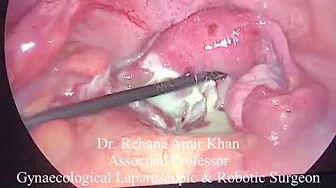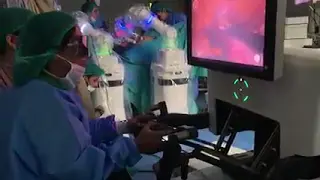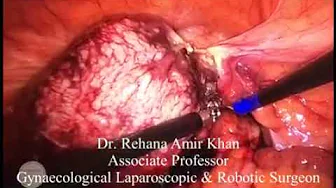Treatment of Polyps And Fibroids
TREATMENT OF POLYPS AND FIBROIDS
Consult the Best Gynecological Laparoscopic Surgeon in Lahore.

With years of experience in Gynecology, we are here to help
Our Specialist Gynecological Laparoscopic surgeons are specialized in all kinds of:
Stop taking fibroids and polyps as normal; it's harmful to you
they can cause some significant problems. Consult our expert gynecological surgeons in Lahore today
Fibroids and polyps are usually benign (noncancerous) tumors in a woman's uterus. While it can be harmless, it can also lead to problems like infertility or repeated miscarriages. Women may also experience pelvic pain, stress, or changes in their menstrual cycle due to fibroids.
Fibroids
Fibroids are harmless tumors arising from the weak muscle of the uterus. Fibroids are usually identified by their location in the uterus. Whether within the uterine wall, extending into the uterine cavity, or on the uterine surface.
There are three types of fibroids:
Healthcare providers may refer to fibroids as adenomas, leiomyomas, or fibroids. These lumps are not cancerous and do not require treatment unless they cause symptoms such as pelvic pain, bleeding, or heavy or uncomfortable periods.
It is estimated that as many as one in five women of reproductive age suffers from uterine fibroids. It is most common in women over 30, rarely seen in women under the age of 20, and is more common in African Americans than Caucasians. Although many women have no symptoms of fibroids, any fibroids can affect reproductive function and lead to infertility or miscarriage.
Although the cause of uterine fibroids is unknown, they grow with the hormone estrogen. Therefore, fibroids typically continue to grow throughout a woman's reproductive years, as long as the woman's circulating levels of estrogen are normal. When hormone levels drop at the onset of menopause, fibroids are more likely to shrink.
Symptoms of Fibroids
Fibroids are benign growths that can occur in the uterus or even outside the uterus. About 75% of women will develop fibroids at some point. Most will be asymptomatic. Many fibroids go away on their own. But it can cause all sorts of uncomfortable and annoying symptoms. Therefore, it is essential to take control of your treatment regimen and not settle for silently suffering from the problems that fibroids can cause:
TREATMENT OF POLYPS AND FIBROIDS
Fibroids Treatment
There are several ways to treat fibroids, but it's important to note that most treatments can affect fertility. These include:
Laparoscopic/Hysteroscopic Removal Of Fibroids
Minimally invasive surgery is done to remove the uterus. Uterine fibroids are the most common cause of laparoscopic hysterectomy. This fibroids treatment is not for women who wish to have children or who wish to preserve their uterus. In some cases, robotic surgical equipment can be used, a da Vinci hysterectomy procedure that allows women who need open surgery to undergo minimally invasive procedures.
In Laparoscopic myomectomy, we remove one or more fibroids that are inside the wall of the uterus or on the outer layer of the uterus. Then these are crushed with special equipment for removal from small incision of 5mm. this procedure is free of risk of adhesions and fibrosis, so tubes and ovaries perform their function after surgery as good as before surgery.
In hysteroscopic myomectomy we remove those fibroids that are on the inner side of the uterus, telescope is inserted into the vagina inside the uterus with out any incision and fibroid is removed under direct vision with special equipment, so we bypass the need of giving cut on the uterus and then going inside the uterus to remove the fibroids. These procedures not only maintain the function of the uterus better than conventional open surgery but at the same time avoid damage to the uterus tubes and ovaries of open surgery. These surgeries are performed with shorter hospital stay, less post operative pain killers, fast recovery and best fertility outcome.
TREATMENT OF POLYPS AND FIBROIDS
Polyp
Endometrial polyps are small tumors within the lining of the uterus or uterus. It is expected in women over the age of 20. However, very few young women who have not yet started menstruating develop polyps.
Women may have one or more polyps. Although they are not usually cancerous, an obstetrician-gynecologist or fertility doctor should evaluate all benign tumors. Polyps are easy to remove and typically do not grow back.
The cause of endometrial polyps is unknown. It can develop from endometrial overgrowth, hyperplasia, or certain medications. The researchers believe polyps may also be an abnormal response to elevated estrogen levels.
Many benign tumors do not interfere with the ability to conceive. However, large or multiple polyps can sometimes cause fertility problems or cause repeated miscarriages.
If you have had recurrent miscarriages or suspect infertility, you should consider seeing a fertility specialist.
TREATMENT OF POLYPS AND FIBROIDS
Symptoms of Uterine Polyps
Some women never have symptoms of polyps. Benign tumors can also develop and then go away on their own. It is essential to watch for significant signs that may indicate persistent or worsening symptoms caused by persistent polyps. Talk to a doctor who knows the difference between polyps and fibroids. Symptoms caused by polyps may be:
Diagnosis of polyps
There are several ways to confirm the diagnosis of endometrial polyps, as they are often overlooked during a pelvic exam:
A hysterogram is an ultrasound that uses sterile water to dilate the uterus and view the uterine cavity.
Hysterosalpingogram uses dye and X-ray images to see the outline of the uterus.
A hysteroscopy uses a viewing device similar to a thin telescope to look inside the uterus and confirm the presence of polyps.
Treatment of Polyps
Polyps don't always need treatment; however, if they do, they should be removed during a hysteroscopy under direct vision. DNC is not curative for polyps. If you want to eliminate it, then the only solution is hysteroscopic removal.
With years of experience as a Gynecologist in Lahore, we have successfully treated thousands of patients who are now enjoying their lives with their loved ones.




